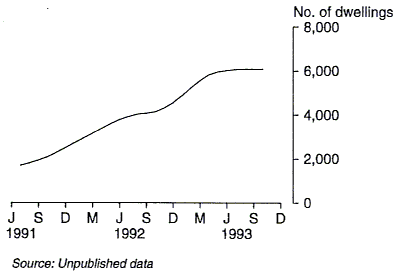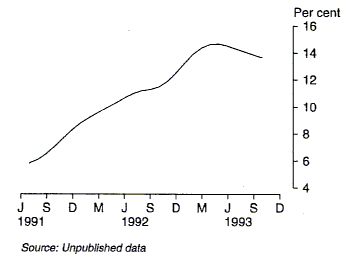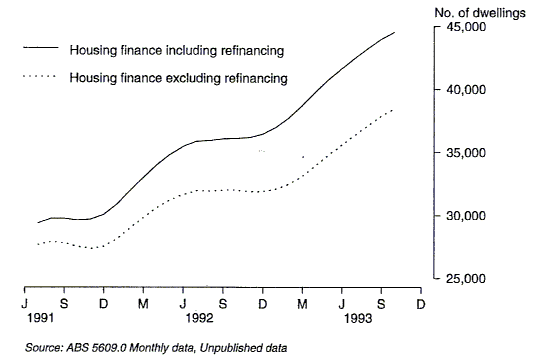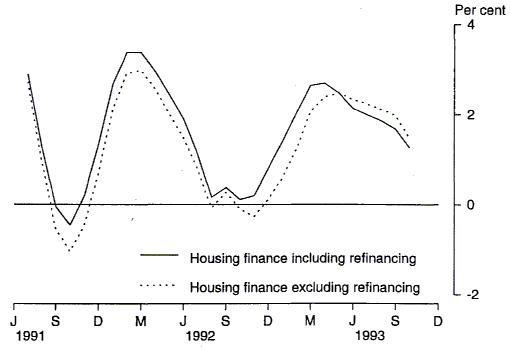- About this Release
- Predicting Private New Capital Expenditure Using Expectations Data, Jan 1994 (Feature Article)
- Impact of Refinancing on Housing Finance Statistics, Mar 1994 (Feature Article)
- Australia's Motor Vehicle Fleet Grows Older, Apr 1994 (Feature Article)
- Real Estimates in the National Accounts, May 1994 (Feature Article)
- The Dynamics of Long-Term Unemployment, Jun 1994 (Feature Article)
- Projections of Australia's Population Growth and Distribution, Jul 1994 (Feature Article)
- Labour Force Participation Rate Projections to 2011, Aug 1994 (Feature Article)
- Business Expectations Survey, Sep 1994 (Feature Article)
- Labour Force Projections to 2011, Oct 1994 (Feature Article)
- Relative Earnings: Private and Public Sector, Nov 1994 (Feature Article)
- Unpaid Work and the Australian Economy, Dec 1994 (Feature Article)
|
1994 Feature Article - Impact of Refinancing on Housing Finance Statistics
This article was published in Australian Economic Indicators March 1994 issue on 1 March 1994.
Introduction
This article examines the impact of the growing level of refinancing within the overall context of housing finance statistics. The ABS has been collecting statistics on secured housing finance commitments, which are published in Housing Finance for Owner Occupation (cat. no. 5609.0), since 1975. Housing finance statistics have always included refinancing of an existing loan, with a different institution, in new finance commitments for housing finance. At the request of users of the statistics, the ABS began collecting separate information on the level of refinancing in July 1991 . Up until that time, refinancing was included with estimates of finance for established dwellings.
This article introduces trend estimates for housing finance commitments excluding refinancing. These estimates have been derived from seasonally adjusted data for refinancing that have been calculated using the assumption that the level of refinancing in the months from January 1990 to July 1991 , was the same percentage of total financing (ie 6 per cent) that it was in July 1991 . The calculations for months since July 1991 have been based on the actual recorded level of refinancing.
The article therefore provides a guide to the effect of the growth in refinancing on the trend in total financing. It is aimed at meeting the request of users for a measure of the trend in housing finance which is not affected by the growth in refinancing. It can only be regarded as a guide in view of the assumption of a constant level of refinancing prior to July 1991.
Role of Housing Finance Statistics as an Economic Indicator
Housing finance statistics are a measure of commitments to purchase or construct dwellings for owner occupancy, and therefore indicate the strength of demand in the domestic housing market. Shifts in the demand for housing have important ramifications for the economic well-being of the domestic economy, and the series is generally recognised as a leading indicator of economic activity in the housing industry, and also for the economy at large. Analysis by the ABS in the development of the composite leading indicator for economic activity has shown that estimates of the value of total housing finance lead turning points in GDP(A) estimates by, on average, three quarters (refer Australian Economic Indicators, October 1992 “Leading Indicators of the Australian Business Cycle”). Similar analysis carried out on the number of dwellings financed series indicate the presence of a like cyclical pattern, with the series leading turning points in GDP(A), however the series is more volatile than GDP(A).
Definition of Refinancing
Housing finance commitments do not include variations of existing agreements; refinancing of an existing loan by the same institution that made the original loan is not regarded as new finance activity. However, all commitments to finance a change in residence, even if the loan is effected by refinancing an existing loan, are treated as new finance commitments. This is because the change of residence by the borrower has a direct impact on the level of housing activity.
Within the framework of the housing finance collection, refinancing is restricted to the financing of an existing loan, by a different institution. This does not represent a lift in the demand for housing, and will have negligible direct impact on the level of overall economic activity.
Categories of housing finance
Total dwellings financed includes refinancing, and can be split into three categories, namely, finance for the purchase of dwellings under construction, finance for the purchase of newly erected dwellings, and finance for the purchase of established dwellings. The latter is by far the largest of the three, accounting for approximately 90 per cent of total housing finance. Refinancing, by definition, applies only to financing the purchase of established dwellings, leaving the finance for dwellings under construction, and the finance for purchase of newly erected dwellings series unaffected.
The Significance of Refinancing
The analysis that follows is based on trend estimates of refinancing that have been derived on the basis of the imputation set out in the second paragraph of this article. Graph 1 illustrates the significant increase in the amount of refinancing undertaken by lending institutions since the collection of data relating to refinancing commenced in July 1991 . The trend number of dwellings refinanced in the last two and a half years has risen from under 2,000 in July 1991 to have almost levelled out at about 6000 per month since May 1993. Graph 2 shows that since July 1991 the contribution of trend estimates of refinancing to trend estimates of total housing finance commitments has grown from around 6 per cent to peak at almost 15 per cent in early 1993. It was this growth that led to requests for trend estimates of total commitments for housing financing excluding commitments for refinancing.
GRAPH 1. REFINANCING, TREND

GRAPH 2. RATIO OF NUMBER OF REFINANCED DWELLINGS TO TOTAL DWELLINGS, TREND

Impact of refinancing on the levels of housing finance
Refinancing has had an upward effect on the level of housing finance. Graph 3 compares the trend in total dwelling units financed, including refinancing, with the trend series that excludes refinancing. The growing divergence between the two trend series indicates the growing contribution of refinancing to the upward trend in total housing finance, as total dwelling units financed has grown faster than the series that excludes refinancing. The trend estimate of the total number of dwelling units financed has been at record levels, and increasing, ever since July 1992 when it reached 35,875, passing the earlier peak of 35,706 dwelling units recorded in June 1988. The trend excluding refinancing passed the same record number in July 1993, supporting the view that the present record levels of housing finance are not only due to growth in refinancing.
GRAPH 3. COMPARISON OF TREND ESTIMATES OF HOUSING FINANCE INCLUDING AND EXCLUDING REFINANCE

It is evident from Graph 3 that the shape of the trend excluding refinancing closely follows the shape of the trend in total dwellings financed suggesting that changes in the growth of the two trends are generally of similar timing and magnitude.
However, a close examination of the trend movements in each series shows that the turning points in the trends are sometimes slightly different while the magnitudes of month on month percentage movements are nearly always different. Table 1 details the levels of housing finance for selected statistical series for the period July 1991 to October 1993. The five columns in the table show data on: total number of dwellings financed (column A); number of new financed dwellings (column B); number of dwellings refinanced (column C); month on month percentage change in total number of dwellings financed (column D); month on month percentage change in new financed dwellings (column E).
TABLE 1. COMPARISONS OF TREND GROWTH IN HOUSING FINANCE
|
 | (A) Total Dwellings Financed | (B) Dwellings under New Finance* | (C)Dwellings refinanced | (D) Month on Month change(A) | (E)Month on Month change(B) |
|
Month
| Number
| Per cent
|
| July 91 | 29,408 | 27,695 | 1,713 | 2.9 | 2.7 |
| August 91 | 29,780 | 27,960 | 1,821 | 1.3 | 1.0 |
| September 91 | 29,767 | 27,815 | 1,952 | -0.1 | -0.5 |
| October 91 | 29,632 | 27,526 | 2,106 | -0.5 | -1.0 |
| November 91 | 29,690 | 27,397 | 2,293 | 0.2 | -0.5 |
| December 91 | 30,082 | 27,581 | 2,502 | 1.3 | 0.7 |
| January 92 | 30,886 | 28,161 | 2,725 | 2.7 | 2.1 |
| February 92 | 31,932 | 28,980 | 2,952 | 3.4 | 2.9 |
| March 92 | 33,012 | 29,845 | 3,168 | 3.4 | 3.0 |
| April 92 | 33,985 | 30,608 | 3,378 | 3.0 | 2.6 |
| May 92 | 34,814 | 31,224 | 3,590 | 2.4 | 2.0 |
| June 92 | 35,475 | 31,687 | 3,788 | 1.9 | 1.5 |
| July 92 | 35,875 | 31,941 | 3,934 | 1.1 | 0.8 |
| August 92 | 35,937 | 31,914 | 4,022 | 0.2 | -0.1 |
| September 92 | 36,075 | 32,001 | 4,074 | 0.4 | 0.3 |
| October 92 | 36,117 | 31,968 | 4,149 | 0.1 | -0.1 |
| November 92 | 36,191 | 31,883 | 4,308 | 0.2 | -0.3 |
| December 92 | 36,479 | 31,919 | 4,561 | 0.8 | 0.1 |
| January 93 | 36,990 | 32,099 | 4,891 | 1.4 | 0.6 |
| February 93 | 37,744 | 32,495 | 5,249 | 2.0 | 1.2 |
| March 93 | 38,741 | 33,163 | 5,578 | 2.6 | 2.1 |
| April 93 | 39,786 | 33,955 | 5,830 | 2.7 | 2.4 |
| May 93 | 40,772 | 34,797 | 5,975 | 2.5 | 2.5 |
| June 93 | 41,646 | 35,605 | 6,040 | 2.1 | 2.3 |
| July 93 | 42,476 | 36,400 | 6,076 | 2.0 | 2.2 |
| August 93 | 43,265 | 37,169 | 6,096 | 1.9 | 2.1 |
| September 93 | 43,992 | 37,899 | 6,093 | 1.7 | 2.0 |
| October 93 | 44,548 | 38,456 | 6,092 | 1.3 | 1.5 |
* Excludes dwellings refinanced
|
The Table and supporting graph (Graph 4) show that growth in housing finance, excluding refinancing, displays some negative growth over the period August 1992 to November 1992. In comparison, the series including financing, shows a continuing, albeit relatively small, upward climb over the same period. The series excluding refinancing displays stronger growth from May 1993 to October 1993, reflecting a decline in the growth of refinancing over this period.
GRAPH 4. COMPARISONS OF TREND GROWTH IN HOUSING FINANCE, CHANGE FROM PREVIOUS MONTH

Contribution of refinancing to monthly movements
Table 2 shows the contribution of refinancing to percentage monthly movements in the number of dwellings subject to housing finance commitments. Column A shows the percentage change in the total number of dwelling units financed, including those refinanced. Column B shows the component of the total movement attributable to new financing and column C shows the component attributable to refinancing. It can be seen that refinancing has contributed up to 1.0 percentage point of the total monthly percentage movement and has sometimes exceeded the contribution of new financing (ie column B). Refinancing has made a positive contribution in most months, including some in which new financing has made a negative contribution. The most recent examples of this were in October and November 1992 when the total number of dwellings financed would have fallen had it not been for refinancing. However, since May 1993, refinancing has made a much more muted contribution to monthly movements - in fact refinancing made no contribution at all in September and October 1993.
TABLE 2. CONTRIBUTION OF COMPONENTS TO MONTHLY GROWTH IN TREND
|
 | (A) Total Dwellings Financed | (B) Dwellings Under New Finance | (C) Dwellings Refinanced |
 |
|
| Month | Per cent | Percentage points |
|
| July 91 | 2.9 | 2.6 | 0.3 |
| August 91 | 1.3 | 0.9 | 0.4 |
| September 91 | -0.1 | -0.5 | 0.4 |
| October 91 | -0.5 | -1.0 | 0.5 |
| November 91 | 0.2 | -0.4 | 0.6 |
| December 91 | 1.3 | 0.6 | 0.7 |
| January 92 | 2.7 | 1.9 | 0.7 |
| February 92 | 3.4 | 2.7 | 0.7 |
| March 92 | 3.4 | 2.7 | 0.7 |
| April 92 | 3.0 | 2.3 | 0.6 |
| May 92 | 2.4 | 1.8 | 0.6 |
| June 92 | 1.9 | 1.3 | 0.6 |
| July 92 | 1.1 | 0.7 | 0.4 |
| August 92 | 0.2 | -0.1 | 0.3 |
| September 92 | 0.4 | 0.2 | 0.1 |
| October 92 | 0.1 | -0.1 | 0.2 |
| November 92 | 0.2 | -0.2 | 0.4 |
| December 92 | 0.8 | 0.1 | 0.7 |
| January 93 | 1.4 | 0.5 | 0.9 |
| February 93 | 2.0 | 1.1 | 1.0 |
| March 93 | 2.6 | 1.8 | 0.9 |
| April 93 | 2.7 | 2.0 | 0.7 |
| May 93 | 2.5 | 2.1 | 0.4 |
| June 93 | 2.1 | 2.0 | 0.2 |
| July 93 | 2.0 | 1.9 | 0.1 |
| August 93 | 1.9 | 1.8 | 0.1 |
| September 93 | 1.7 | 1.7 | 0.0 |
| October 93 | 1.3 | 1.3 | 0.0 |
*Excludes dwellings refinanced
|
Conclusion
The analysis above indicates that refinancing has had a significant impact on the level and monthly movement of the trend in housing finance, though the impact on monthly movements has been far more muted in the most recent periods. The introduction of the trend estimates for refinancing has shown that, although growth in total new finance commitments has been influenced by a significant lift in the demand for refinancing, the evidence of healthy growth in the housing sector is not misleading. However, as occurred in late 1991, growth in the demand for refinancing can disguise a slowdown in the housing sector. For these reasons the ABS will publish, in the January 1994 and subsequent monthly issues of Housing Finance for Owner Occupation (cat. no. 5609.0), the trend estimates for refinancing, and total financing excluding refinancing.
The ABS would welcome any comment from users of the statistics in this article and on ways the ABS can assist users to make better use of housing finance statistics.
This feature article was contributed by John Carson, ABS.
|
 Print Page
Print Page